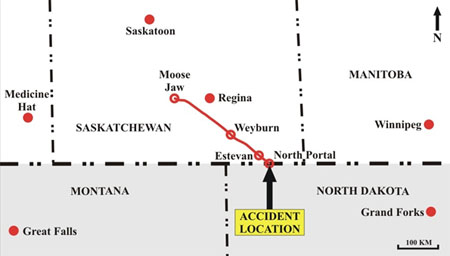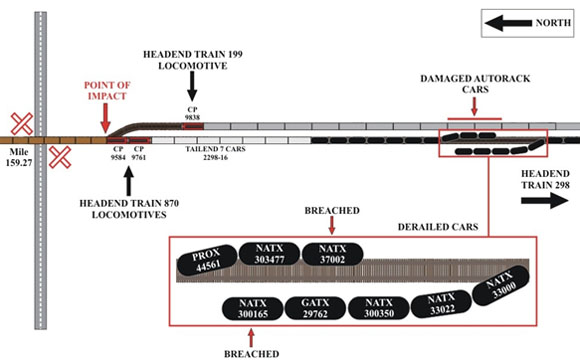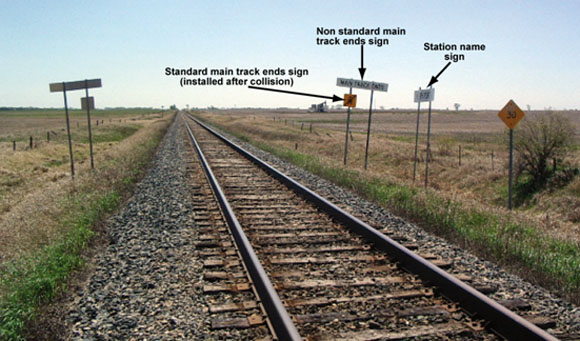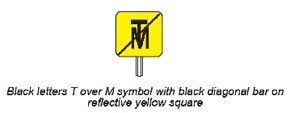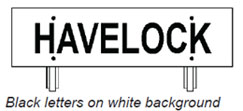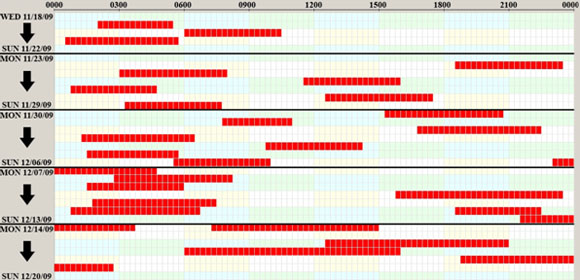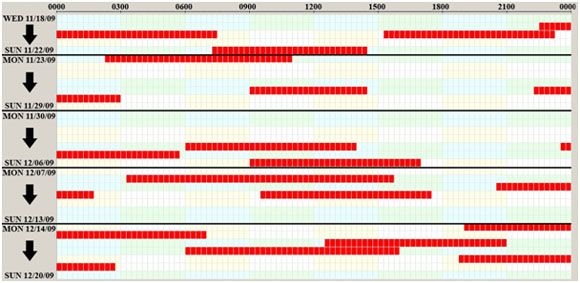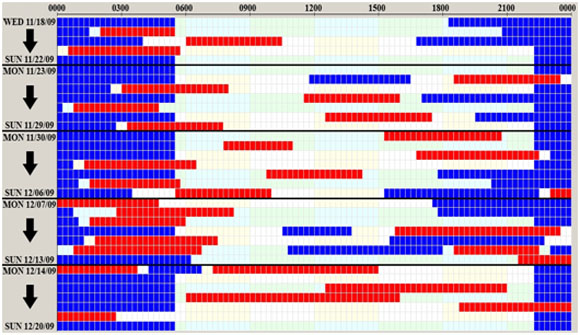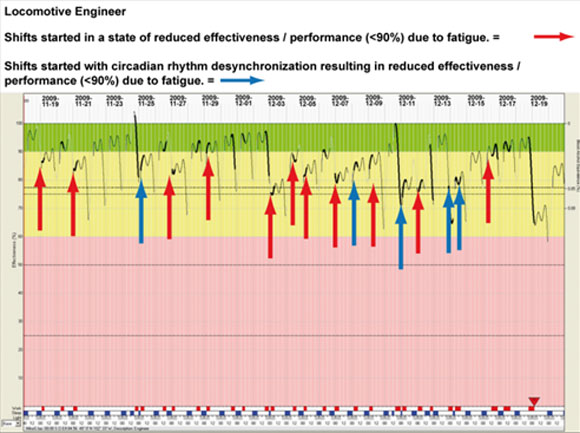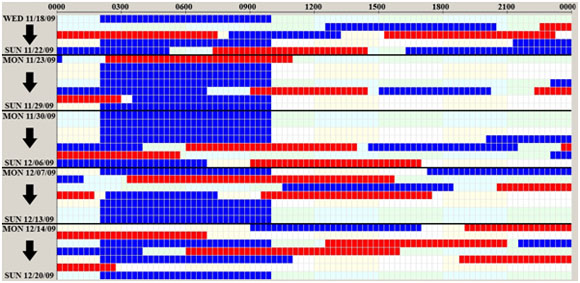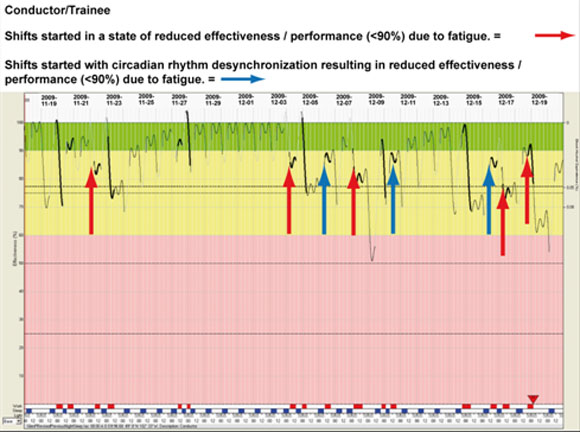Non-main-track train collision
Between
Canadian Pacific Railway freight train 870-013,
Canadian Pacific Railway freight train 2-298-16, and
Canadian Pacific Railway freight train 2-199-15
Mile 159.31, Weyburn Subdivision
North Portal, Saskatchewan
The Transportation Safety Board of Canada (TSB) investigated this occurrence for the purpose of advancing transportation safety. It is not the function of the Board to assign fault or determine civil or criminal liability. This report is not created for use in the context of legal, disciplinary or other proceedings. See Ownership and use of content. Masculine pronouns and position titles may be used to signify all genders to comply with the Canadian Transportation Accident Investigation and Safety Board Act (S.C. 1989, c. 3).
Summary
On 19 December 2009, at 0223 Central Standard Time, southward Canadian Pacific Railway (CP) freight train 870-013 collided with the tail-end of southward CP freight train 2-298-16 which was stationary on the same track at Mile 159.31 of the Weyburn Subdivision at North Portal, Saskatchewan. Eight residue tank cars (last contained gasoline, UN1203) from freight train 2-298-16 derailed and struck 2 auto rack cars from CP freight train 2-199-15, which was stationary in an adjacent track. One locomotive from train 870-013 and 24 freight cars from the other 2 trains were damaged. There were no injuries. No product was released.
Ce rapport est également disponible en français.
Factual information
The accident
On 19 December 2009, at 0132,Footnote 1 southward Canadian Pacific Railway (CP) freight train 2-298-16 (train 298), powered by 2 head-end locomotives and consisting of 69 loads and 43 empties, stopped on the Canadian Main track in the yard at North Portal, Saskatchewan. It weighed about 10 135 tons and measured approximately 7450 feet. At 0157, northward CP freight train 2-199-15 (train 199) stopped on an adjacent yard track. It was powered by 1 head-end locomotive and consisted of 54 loads, weighed about 3895 tons and measured approximately 5140 feet. The crew members for both trains were qualified for their positions and met regulatory fitness and rest requirements.
At 2000 on 18 December 2009, southward CP freight train 870-013 (train 870) departed from Moose Jaw, Saskatchewan (Mile 0.0) on the Weyburn Subdivision, destined for North Portal (Mile 158.0). Train 870 was powered by 2 head-end locomotives and 1 tail-end remote locomotive and was hauling 108 loaded cars; it weighed about 14 275 tons and was about 5950 feet long. The crew consisted of a conductor/locomotive engineer trainee (trainee), who operated the train from Moose Jaw to North Portal (see Figure 1), and a locomotive engineer, who provided coaching to the trainee while en route and fulfilled the duties of the conductor. Both crew members for train 870 were qualified for their positions and met regulatory fitness and rest requirements.
As train 870 was en route, the rail traffic controller informed the crew that train 199 and train 298 were both at North Portal and that train 298 was awaiting permission to cross into the United States. The crew planned to stop at the north switch at Mile 159.31, drop off a crew member, pull the train past the switch, stop and cut off the tail-end remote locomotive. Once train 199 would have left the adjacent yard track, the crew planned to move the train 870 tail-end locomotive along the track and place it at the head-end of the train.
Approaching North Portal, train 870 was travelling at about 35.0 mph with the throttle in position 8. From 0217:53 to 0218:15, train 870 sounded the horn for a crossing at Mile 156.80. After passing by the north station mile signFootnote 2 at Mile 157.00, the throttle position was slowly reduced, placed into idle, and the train began to slow down. The horn was again sounded from 0219:37 to 0220:05, 0220:51 to 0220:58 and 0222:50 to 0223:07 for additional crossings at Mile 157.80, Mile 158.22 and Mile 159.27.
At 0223:08 (Mile 159.13), the train had slowed to approximately 24 mph and dynamic braking (DB) was initiated. The engineer was completing the conductor's paperwork as the train approached the north switch when he looked up and saw the tail-end of train 298 on the track ahead. At 0223:24, while travelling at 21 mph, the train was placed into emergency (Mile 159.24). While travelling at 17 mph, train 870 collided with the tail-end of train 298 (Mile 159.31) and came to rest with the lead locomotive located at Mile 159.35 (see Figure 2). Local emergency service personnel responded. There were no injuries.
At the time of the collision, the temperature 20 miles away at Environment Canada's weather station at Estevan, Saskatchewan was −13°C with freezing fog and a visibility of 400 metres (1310 feet). Patches of thick fog along the Weyburn Subdivision from Moose Jaw to North Portal sporadically reduced visibility. In the vicinity of the main-track-ends sign, the visibility was poor.
Site examination
The lead locomotive of train 870 sustained impact damage but did not derail, nor did any of the cars from train 870. The 91st to the 98th cars from train 298, all residue tank cars last containing gasoline (UN1203), derailed. The 95th and 96th cars were breached but no product was lost. The 99th to 112th cars sustained minor impact damage but did not derail. Cars from train 199 were struck by the derailing cars from train 298; 2 loaded auto rack cars sustained minor damage. Approximately 150 feet of track was damaged.
Weyburn Subdivision
The Weyburn Subdivision consists of a single main track that extends, in a north-south direction, from Moose Jaw to the international border with the United States (Mile 160.80) at North Portal. Traffic volumes are about 550 million gross ton miles per year with an average of 10 trains per day. Train movements are governed by the Occupancy Control System as authorized by the Canadian Rail Operating Rules (CROR) and supervised by a rail traffic controller located in Calgary, Alberta. The track is classified as Class 4 track according to the Railway Track Safety Rules. Track speed is 50 mph up to the North Portal station name sign at Mile 158.0.
The main track ends at Mile 158.0. From this point, non-main-track territory extends to Mile 160.8. This extension is known as the Canadian Main. A yard track adjacent to the Canadian Main extends from the switch at Mile 159.31 to Mile 160.4. Train speed within the non-main-track territory is restricted in the timetable special instructions to 30 mph and is governed by the CP CROR Rule 105 (Speed on Non-Main Track). The end of the main track (Mile 158.0) is marked by a non standard main-track-ends sign (see Photo 1); the sign is the only one of its kind in the Saskatchewan service area.
A standard main-track-ends sign is shown in Figure 3. There is a station name sign in the general vicinity of the main-track-ends sign and a whistle post several feet to the north. Station mile signs are located on the west side of the right of way at Mile 157.00 and on the east side at Mile 159.00. Station mile signs (see Figure 4) and the non standard main-track-ends sign resemble each other and are both oriented perpendicular to the track direction. Station name signs (which resemble station mile signs and the non standard main-track-ends sign) are positioned parallel to the track direction.
Canadian Rail Operating Rules
The CROR Rule 14L governing the whistling at grade crossings states in part that:
Movements operating at 44 mph or less must sound whistle signal to provide 20 seconds warning before entering the crossing and continuing to sound whistle signal until crossing is fully occupied.
CP System Special Instruction to Rule 105 (Speed on Non-Main Track) states in part that:
Unless otherwise provided by signal indication, a movement using non-main track must operate at REDUCED speed ...
- Unless otherwise provided by signal indication or special instructions, movements operating on non main tracks must not exceed fifteen (15) MPH on sidings and 10 MPH on other than sidings.
- In addition to moving at REDUCED speed, a movement using a non-signalled siding or using other non main tracks so designated in special instructions, must operate at a speed that will allow it to stop within one-half the range of vision of a track unit or stop short of maintenance equipment foul of the track.
The CROR defines 'reduced speed' as "a speed that will permit stopping within one-half the range of vision of equipment."
Crew of train 870
Locomotive engineer
The locomotive engineer qualified for the position and received familiarization training on all subdivisions operating from the Moose Jaw terminal in 1987. He was also trained and qualified to coach trainees in CP's Locomotive Engineer On-the-Job Training (OJT) program.
Since 2005, the locomotive engineer operated almost exclusively on the Swift Current Subdivision. During that time, the only tripFootnote 3 taken on the Weyburn Subdivision was on 16 and 17 December 2009 when he operated a train from Moose Jaw to North Portal and back. While the locomotive engineer preferred to work on the Swift Current Subdivision with its shorter runs, his senority allowed him to secure a position on the Weyburn Subdivision and he elected to fill a short term vacancy on that route.
The locomotive engineer worked 28 shifts during the 30 days prior to the occurrence, including the occurrence shift. This shift schedule met the mandatory off-duty time and maximum duty times outlined in Transport Canada's (TC) Work/Rest Rules for Railway Operating Employees (Work/Rest Rules)(see Appendix A). Start and finish times varied considerably with no predictable pattern (see Figure 5).
Trainee
The trainee qualified as a conductor in 1997. Since 2005, he worked as a conductor mainly out of the Moose Jaw terminal, primarily on either the Swift Current or Indian Head Subdivisions and seldom on the Weyburn Subdivision.
In March 2009, the trainee began the Locomotive Engineer OJT program. Between March 2009 and December 2009, he had been evaluated as a locomotive engineer trainee 63 times. Thirteen of those evaluations were conducted during 7 trips on the Weyburn Subdivision. Five of those trips were as far south as North Portal. His most recent trip to North Portal was on the 16 to 17 December 2009 with the locomotive engineer involved in the collision; on this occasion no evaluation was completed. In the reports completed after 12 August 2009, most of the evaluation criteria were graded as "Achieves Standard".
The trainee worked 16 shifts during the 30 days prior to the occurrence, including the occurrence shift. This shift schedule met the mandatory off-duty time and maximum duty times outlined in TC's Work/Rest Rules. Start and finish times varied considerably with no predictable pattern (see Figure 6).
Crew work scheduling practices
CP's freight trains operate on an unscheduled basis and consequently crews are called for trips as required. Trips are assigned to crews in subdivision "pools", based on a first-in first-out system, subject to mandatory off-duty time and maximum duty times outlined in the Work/Rest Rules. When crew members finish a trip, their names are placed back into the pool list for reassignment to their next trip. In addition to the rest period requirements of the Work/Rest Rules, crews are entitled to book up to 24 hours of rest at their home terminal and up to 8 hours at their away terminals.
Since trains are not scheduled, crews can work out an approximate arrival and departure time for their next trip from the list of upcoming trains. For example, if an employee's name is fourth on the pool list, they will review the train line-up and estimate the arrival time of the fourth train. Train line-ups are not intended for use as a scheduling tool or as an authority for train movement. However, train crews use them informally to estimate the sequencing, timing, and approximate location of trains due into their terminal.
Train line-ups and estimated arrival times can change dramatically within a short period of time depending upon factors such as delays related to the number of trains travelling in the opposite direction on the same track, the number of slow orders in effect, the number of mechanical problems, and delays due to track repairs. It is also possible for a train to be cancelled altogether. Although CP seeks to manage train line-up accuracy and has made it a performance metric, these factors increase the variability and unpredictability of a train's arrival time and the associated call times for the crew.
When planning their work, crews call a dedicated telephone number and receive an automated response estimating the time of their next trip. There is no method for crews to reliably predict when they will be working beyond their next shift.
CP's training for locomotive engineer coaches
A select group of experienced locomotive engineers are chosen to become coaches for CP's Locomotive Engineer OJT program. To become a coach, each candidate must complete a 1 ½ day workshop. Topics covered during the workshop include Creating the Right Climate for Coaching, Essential Skills for Coaches, The Collaborative Coaching Process, and Coaching Challenging Individuals. In addition to the coaching workshop, coaches must maintain a 90% grade during their Rules Qualification course.
CP's locomotive engineer OJT program
To qualify as a locomotive engineer, trainees must successfully complete the Locomotive Engineer OJT program. The program includes:
- 3 weeks of in-class mechanical and rules instruction,
- 1 week of one-on-one instruction in the field from a qualified locomotive engineer,
- up to 18 months OJT training with locomotive engineers who have completed CP's coaching program,
- a final written examination, and
- subdivision qualification.
To earn their subdivision qualification, trainees take several trips on a subdivision until they are proficient at train handling. Once this is complete, trainees must pass a "road test" performed by a qualified company officer who rides in the cab and evaluates their performance over the subdivision before qualifying them. Trainees must be qualified on each subdivision that they will be operating on. The trainee completes the program while fulfilling the duties of a conductor.
Crew subdivision qualification
Once qualified on a subdivision, locomotive engineers need not re-qualify as long as they have not been absent from service for an extended period of time and have retained a valid certificate of rules qualification. Crew members may request familiarization trips on subdivisions where they have not worked for a period of time. Familiarization trips involve riding with another crew over a specific subdivision. Crews are paid for any necessary additional familiarization training which includes training required because of long absences from working on a subdivision.
Any crew member who is absent from service for any reason must comply with Occupational Health and Safety's Return to Work Policy. In addition (and provided they have retained a valid certificate of rules qualification), CP requires that employees who have been off work for more than 18 months receive full rules qualification training and pass all examinations required for their level of qualification, upon which they receive a new rules card. Also, crew members must re-qualify on each subdivision.
Proficiency testing
CP regularly conducts proficiency testing on its train crews to evaluate their skills in train operation and adherence to rules. These tests are conducted through observations while riding with a crew in the cab and by other methods such as observation from the ground, evaluation of event recorder downloads, monitoring radio communication and performing radar tests. From 2007 to 2009, the locomotive engineer was evaluated 16 times and achieved the necessary standard 13 times. The other tests highlighted a concern with inspection of passing trains, communication with the rail traffic controller, confirmation of switch position, and possession of required documents. After each test on which he did not achieve the standard, he received verbal coaching.
During the same period the trainee was tested 31 times as a conductor and did not achieve the standard on only one occasion. That test highlighted a concern with the use of the engine number in communications.
Circadian rhythm desynchronization
Humans have numerous daily (circadian) biological rhythms that influence their body's internal and external functions. Some estimates suggest that hundredsFootnote 4 of these types of rhythms exist such as body temperature, heart rate, subjective fatigue, attention, drowsiness, peak expiratory flow, and grip strength. There are also circadian rhythms for performance and cognitive functioning.Footnote 5 These rhythms can influence performance on specific measurements such as reaction time,Footnote 6 arithmetic and signal detection,Footnote 7 and train safety alarm alerts.Footnote 8 Many circadian rhythms are interdependent and synchronized to each other as well as to the time of day. Researchers have found that circadian rhythms can become desynchronized due to changes in sleep-wake patterns.Footnote 9
Desynchronization occurs because each biological rhythm adapts to a new sleep-wake pattern at a different rate.Footnote 10 For example, a traveller's hunger pattern may be able to adjust to a new sleep-wake pattern more quickly than the body temperature pattern. Desynchronization can cause fatigue, daytime sleepiness, psychomotor impairment,Footnote 11 impaired performance, insomnia,Footnote 12 other sleep disturbances, reduced cognitive skills, and muscle fatigue.Footnote 13 Symptoms of desynchronization will often result in a further reduction in sleep time and quality.Footnote 14 Employees working on shifts with variable start and finish times will constantly be susceptible to the development of desynchronization, regardless of the length of time one has worked variable shifts.Footnote 15 Some researchers estimate that a stable sleep-wake pattern and exposure to appropriate external time cues such as light and darkness are required for at least 8 days for resynchronization to occur.Footnote 16
Allowing people enough time to biologically adjust to different shift schedules reduces the risk of performance decrements. Less than adequate adjustment periods and complex schedules that reduce the predictability of work and social responsibilities increase the risk of fatigue.Footnote 17
Fatigue avoidance scheduling tool
Analyses of the crew's sleep-wake histories were completed with the Fatigue Avoidance Scheduling Tool (FASTFootnote 18). FAST consists of computer software that employs the Sleep, Activity, Fatigue, and Task Effectiveness (SAFTEFootnote 19) mathematical model and sleep-wake schedule data. FAST uses the inputs to predict fatigue factors that are likely to increase the risk of human performance decrements as well as specific human performance metrics. Although the predictions from this software may not be accurate for any given individual or situation, this information is intended to help managers and individuals design work and sleep schedules that reduce the risk of fatigue and fatigue induced errors.
To assess and forecast performance changes associated with sleep-wake patterns resulting from work schedules similar to the crew's schedule, a hypothetical sleep schedule based upon the crew's work schedule, their normal sleep pattern, and known sleep periods was used (see Appendix B). Although FAST does not provide a predicted level of fatigue as a numerical outcome measure, it does provide a numeric prediction of effectiveness that is derived from a predicted level of fatigue. The performance decrements predicted by FAST accurately predict the likelihood of human factors accidents.Footnote 20
FAST was used in the analysis of this occurrence in order to obtain an indication of the likely relationship between working shifts with variable start times and the potential for fatigue. Because detailed sleep information was not available for either crew member, the FAST analysis is directed towards ascertaining risk factors and not cause.
FAST results are not intended to be used as a single tool of fatigue measurement to evaluate individuals. To evaluate an individual, these results would be compared to the current state of the scientific literature, validated against facts gathered throughout the investigation and compared to the individual's sleep pattern. This approach ensures a reliable estimate of an individual's fatigue and human performance.
The locomotive engineer's normal sleep pattern was to start sleeping between 2200 and 2230 and to stop sleeping around 0530 to 0545, which provided an average of 7.25 hours of total sleep per night (including awakenings). When he could not attain 7.25 hours of sleep, he would supplement his nighttime sleep with a nap. The locomotive engineer's sleep was normally interrupted by 1 or 2 brief awakenings per night, after which sleep was quickly resumed. Calls for duty starting at the home terminal prevented sleep from occurring for 2 hours prior to work and calls for duty at the away terminals prevented sleep from occurring for 30 minutes prior to work.
The trainee's normal sleep pattern was to obtain between 7 and 8 hours of sleep starting between 0100 and 0200. In addition, when the trainee could predict that he would be working a night shift he would attempt to obtain his sleep during the day. The trainee did not normally experience awakenings. A call-for-duty prevented sleep from occurring for 2 hours prior to work at all terminals. The only sleep period that the trainee could recall accurately was the period immediately preceding the occurrence. He slept from 0200 to 1100 on 18 December 2009.
The FAST analysis indicated that during the previous 30 days, employees who worked a schedule similar to that of the locomotive engineer would have been at risk of starting 16 of 28 shifts in a state of reduced effectiveness due to fatigue. However, the accident shift would not have been one of these shifts. Of those 16 shifts, the reduced effectiveness would have been a direct result of circadian rhythm desynchronization 5 times (see Appendix B). Employees who worked a schedule similar to that of the trainee would have been at risk of starting 8 of 16 shifts in a state of reduced effectiveness due to fatigue; one of these shifts would have been the accident shift. The reduced effectiveness for 3 of the 8 shifts would have been a direct result of circadian rhythm desynchronization. At the time of the accident, after being on duty for 8 hours, both crew members would have been at risk of experiencing reduced effectiveness. The crew's reduced effectiveness would not have been due to circadian rhythm desynchronization.
Other Occurrences
The TSB has conducted investigations into 5 rail occurrences since 2003 where fatigue was listed as either a contributing factor or a risk (R03W0169, R05C0082, R06W0079, R07E0129 and R07V0213). In 3 of the 5 occurrences, the crew's variable work schedule likely led to a desynchronization of their circadian rhythms and fatigue.
Analysis
No deficiencies were identified with either the rolling stock or the track that would have contributed to the collision. In this occurrence, the crew did not comply with CROR rules. There is a common perception pertaining to rules-based industries that, once it has been determined that there was non-compliance to a rule, the non-compliance is cited as the cause. However, this approach does not attempt to explain what contributing factors led to the non-compliance. The analysis will focus on the cause and contributing factors surrounding the accident, including the operation of train 870, the crew's awareness of their proximity to train 298 and subdivision familiarization, as well as the risks associated with operator fatigue and non-standard signage.
The accident
The crew from train 870 were aware of the presence of both train 298 and train 199. They planned to stop prior to the switch at Mile 159.3 to facilitate cutting off the tail-end remote locomotive. However, the train was not slowed sufficiently and consequently collided with the tail-end of train 298 at Mile 159.31 while travelling at a speed of about 17 mph.
Approaching North Portal, train 870 sounded its horn for at least 20 seconds for crossings located at Mile 156.8 and 157.8 in accordance with the CROR. In contrast, the horn was only sounded for 7 seconds when train 870 was close to the crossing at Mile 158.22. Although the crew was expected to be watching for signs along the right of way, this suggests that the crew was surprised by the crossing and had passed by Mile 158.0 without observing the whistle post. Since the non standard main-track-ends sign and the station name sign were located in the same general area, it is likely that the crew also did not observe the other signs or realize that they had entered the CROR Rule 105 territory at North Portal. Furthermore, the fog present at the time of the accident limited the crew's visibility and hindered their ability to detect the signs at Mile 158.0.
Other than operating a train from Moose Jaw to North Portal 2 days prior, train 870 crew's experience on the Weyburn Subdivision was limited. Consequently, they did not have a well developed set of informal geographic cues, such as grade crossings, that fully-familiarized locomotive engineers use as an aid when making train handling decisions. Once train 870 had entered the CROR Rule 105 territory without the crew recognizing it, the crew's experience on the subdivision was not sufficient to aid them in quickly understanding exactly where they were along their route.
As a locomotive engineer trainee in CP's Locomotive Engineer OJT program, the trainee was permitted to handle the train from Moose Jaw to North Portal.The locomotive engineer performed the conductor's duties and worked as an OJT trainer providing guidance to the trainee. Although both crew members had taken on different responsibilities, they were both still responsible for the safe operation of the train. As train 870 approached North Portal, the locomotive engineer chose to attend to the conductor's paperwork and was not focussed on the operation of the train which left the trainee unsupervised.
Crew fatigue
Detecting and reacting to signage along the right of way requires cognitive functions such as alertness, attention and an ability to react to stimuli. These functions become even more crucial when operating with limited visibility, such as during times of heavy fog when the time available to detect and react to cues is reduced. These cognitive functions can be significantly impaired by fatigue which can be induced by a number of factors, including circadian rhythm desynchronization.
Research has demonstrated that the risk of fatigue and impaired performance is generally heightened by variable and unpredictable shift start times. The variability makes it difficult for crews to sleep at an optimal time to ensure that they remain alert for their entire shift, especially when the time between shifts is not sufficient to allow circadian rhythms to adapt. The FAST analysis of the occurrence crew's actual work schedule and hypothethical sleep schedule over the previous 30 days (assuming 7.25 hours of sleep per night for the locomotive engineer and 8 hours for the trainee) identified that the crew could have been at risk of fatigue related performance decrements due to circadian rhythm disruption at the beginning of several shifts during that period; this was not the case however for the crew at the beginning or during the accident shift. Therefore, operating crews that work variable and unpredictable work schedules similar to that of the occurrence crew may be at increased risk of performance impairment due to fatigue.
Subdivision familiarization
To operate safely on a subdivision, locomotive engineers must be familiar with the operation of a locomotive and the characteristics of the subdivision. To ensure that they are, railways provide mechanical and rules instruction as well as subdivision qualification training prior to initially qualifying a locomotive engineer. Furthermore, locomotive engineers that wish to resume their duties after a work absence of more than 18 months must again receive full rules instruction and subdivision qualification training, before being allowed to operate on that subdivision.
However, once a locomotive engineer has been qualified to operate on a subdivision there are no requirements for additional subdivision training should the locomotive engineer not operate on that subdivision for an extended period of time. For example, the locomotive engineer on train 870 was fully qualified on the Weyburn Subdivision though he had not operated on it for about 5 years prior to his trip on 16 to 17 December 2009. The accident occurred on the subsequent trip (19 December 2009).
When qualified locomotive engineers have not worked on a particular subdivision for an extended period of time, familiarization training is available upon request. However, they may not always properly assess their need for additional training. Without appropriate familiarization training, these locomotive engineers may not have adequate region-specific geographic cues to reference in order to safely operate trains, especially when they operate trains in conditions with limited visibility. CP's subdivision familiarization practices do not ensure that all locomotive engineers are familiar with the subdivision on which they are qualified to operate, and therefore a risk remains that locomotive engineers make inappropriate operating decisions leading to accidents.
Non standardized signage
The main-track-ends sign at Mile 158.0 was non standard in its design. It more closely resembled a station mile sign, such as the one at Mile 157.0, than a standard main-track-ends sign. Station mile signs inform locomotive engineers that they are 1 mile from a station. As the non standard sign is the only sign of its kind that crews operating out of Moose Jaw would encounter, crews unfamiliar with the Weyburn Subdivision may not immediately recognize this sign and could mistake it for a station mile sign, especially when a crew is operating in limited visibility. The use of little known, non standard signs increases the risk of misinterpretation and may result in a crew making an inappropriate, safety-critical, train handling decision.
Findings
Findings as to causes and contributing factors
- After leaving the main track, train 870 was not slowed to a safe speed and consequently collided with the tail-end of train 298 at Mile 159.31 while travelling at a speed of about 17 mph.
- The horn was only sounded for 7 seconds when train 870 was close to the crossing at Mile 158.22. This suggests that the crew was surprised by the crossing and had passed by Mile 158.0 without noticing the whistle post.
- Although expected to watch for signs along the right of way, it is likely that the crew did not observe any of the signs in the vicinity of the whistle post or realize that they had entered the Canadian Rail Operating Rules (CROR) Rule 105 territory at North Portal.
- The fog present at the time of the accident limited the crew's visibility and hindered its ability to detect the signs at Mile 158.0.
- Once train 870 had entered the CROR Rule 105 territory without the crew recognizing it, the crew's experience on the subdivision was not sufficient to aid them in quickly regaining locational awareness.
- As train 870 approached North Portal, the locomotive engineer attended to the conductor's paperwork and consequently was not focussed on the operation of the train which left the trainee unsupervised.
Finding as to risk
- Operating crews that work variable and unpredictable work schedules may be at increased risk of performance impairments due to fatigue.
- CP's subdivision familiarization practices do not ensure that all locomotive engineers maintain familiarity with the subdivision on which they have been qualified to operate and therefore a risk remains that locomotive engineers make inappropriate operating decisions leading to accidents.
- The use of non standard signs increases the risk of misinterpretation and may result in a crew making an inappropriate safety critical train handling decision.
Safety action
Action taken by Transport Canada
In September 2010, Transport Canada (TC) finalized and published a study titled Fatigue Management Plans: Requirements and Assessment Guidelines. This document addresses areas of specific high-risk conditions under which a person can exhibit the negative or detrimental effects of fatigue. Given such conditions, fatigue management plans are to be designed to minimize the possibility of fatigue occurring, and/or counteract the detrimental effects of fatigue should it occur.
TC is reviewing the current Work/Rest Rules for Railway Operating Employees and will be involving unions and the industry in strengthening the requirements in the area of second tours of duty and windows.
Action taken by Canadian Pacific Railway
CP continues to roll out a fatigue risk management program using a biomathematical software application developed in Australia.
The standard sign indicating the end of the main track has been posted at North Portal.
A detailed safety investigation was completed to further investigate and develop system improvements. Other safety actions that have been completed include:
- Increased proficiency testing in and around North Portal. Testing specific to in cab communications and auditing of written documentation such as clearances, authorities, restrictions.
- Increased peer observations with specific attention paid to rules 315 and 105 of the Canadian Rail Operating Rules as well as to job briefings.
- Use of On Board Job Briefing Forms (OBJB), effective July 7, 2010.
This report concludes the Transportation Safety Board's investigation into this occurrence. Consequently, the Board authorized the release of this report on .
Appendices
Appendix A - Work rest rules for railway operating employees
Note: This Transport Canada document is available online at http://www.tc.gc.ca/eng/railsafety/rules-tco140-364.htm.
1. Short Title
1.1 These Rules may be referred to as the "Work/Rest Rules".
2. Statements Of Principle
2.1 To meet the safety and operational challenges of managing operating employee fatigue, railway companies, in association with operating employees and their designated representatives, must have a flexible approach that will:
- take ongoing advantage of new developments in research and technology,
- meet operating employees' needs,
- meet operational needs of the railway companies, and
- be implemented over a wide range of operating conditions.
2.2 Railway companies shall establish and maintain working conditions that allow:
- operating employees sufficient opportunity to obtain adequate rest between tours of duty, and
- alertness to be sustained throughout the duty period.
2.3 Operating employees have a responsibility to report for work rested and fit for duty.
3. Scope
3.1 The Work/Rest Rules have been developed pursuant to section 20 (1) of the Railway Safety Act, R.S. 1985, c.32 (4th Supp).
3.2 These Rules apply to railway companies and operating employees under the jurisdiction of the Department.
3.3 These Rules define the requirements for hours of work and rest for such persons.
3.4 For the purpose of calculating on-duty time under these Rules, United States railroad employees operating in Canada will include all time on-duty in the previous 24 hours, regardless of where that service was performed.
4. Definitions
"Arbitrary Time" or "Allowance" means time paid for duties that do not require the employee to be in control of or engaged in the physical operation or switching of trains, engines or equipment.
"Call Time" means the amount of advance notice given to operating employees before going on duty as established by the respective railway company.
"Class of Service" means designated as road, passenger, commuter, work, or yard service on a railway company subject to the jurisdiction of the Department.
"Deadheading" means the authorized transportation of operating employees from one location to another, but does not include travel allowances when paid for commuting to a reporting location.
"Department" means the Department of Transport.
"Designated Representative" means a person designated by a recognized association or organization that has been formed to represent the interests of operating employees on a particular railway company. Where there is no recognized association or organization, the operating employees on the railway company shall elect a person from the railway company to act as the designated representative.
"Emergency" means a sudden or unforeseen situation where injury or harm has been sustained, or could reasonably be sustained to employee(s), passenger(s), the public or the environment such as those involving a casualty or unavoidable accident, an Act of God, severe storms, major earthquakes, washouts, derailments or where there has been a delay resulting from a cause not known to the railway company at the time employees leave the terminal and which could not have been foreseen.
Except as outlined above, normal operating problems that are inherent in railway operations that do not constitute an "Emergency", include but are not limited to:
- crew shortages
- broken draw bars
- locomotive malfunctions
- equipment failure
- broken rails
- hot boxes;
- switching
- doubling hills
- meeting trains
- train length
It is incumbent upon railway companies to establish that excess service could not have been avoided. When an emergency situation does occur, railway companies must exercise due diligence to avoid or limit such excess service.
"Final Time" means arbitrary time associated with administrative duties at the end of a shift or tour of duty.
"Fit for Duty" means reporting for duty rested and prepared to maintain alertness for the duration of the tour of duty.
"On-Duty Time" means the total elapsed time from when an operating employee goes on-duty until the time when an employee goes off-duty but does not include preparatory time, final time, travel allowances and other arbitrary or allowance payments.
"Operating Employee" means a locomotive engineer, conductor, trainman, yardman, pilot, operator of remote control locomotives and operator of light rail passenger equipment, as well as any person whose preponderance of time is spent in such classifications, working in any class of service who is physically involved in the operation or switching of trains, engines and equipment. Any other person who performs the duties of an operating employee is deemed to be an operating employee while those duties are being performed.
"Preparatory Time" means arbitrary time associated with administrative duties when preparing for a shift or tour of duty.
"Shift or Tour of Duty" means a single continuous period on-duty in any class of service, except split shifts, which are comprised of distinct duty periods.
"Ticket Splitting" means when operating employees are placed off-duty and on-duty, while enroute, expressly for the purpose of circumventing the maximum on-duty time provisions contained in subsection 5.1.1.
"Travel Allowance" means an allowance paid for an operating employee to commute to a reporting location.
5. Minimum Requirements
5.1 Maximum Duty Times
- The maximum continuous on-duty time for a single tour of duty operating in any class of service, is 12 hours, except work train service for which the maximum duty time is 16 hours. Where a tour of duty is designated as a split shift, as in the case of commuter service, the combined on-duty time for the two on-duty periods cannot exceed 12 hours.
- When calculating on-duty time as outlined above, arbitrary time or allowances are not to be included. Preparatory and final times each shall not exceed 15 minutes.
5.1.2 Ticket splitting in order to circumvent compliance with subsection 5.1.1 is prohibited.
5.1.3 The maximum combined on-duty time for more than one tour of duty, operating in any class of service, cannot exceed 18 hours between 'resets' as outlined in subsection 5.1.4.
5.1.4 The following is required to 'reset' the calculation of combined on-duty time to zero:
- at the home terminal, 8 continuous hours off-duty time, 'inclusive' of call time, when entering into yard service or,
- at the home terminal, 8 continuous hours off-duty time, 'exclusive' of call time if applicable, when entering into road service or,
- at other than the home terminal, 6 continuous hours off-duty, 'exclusive' of call time if applicable.
5.1.5 Operating employees involved in an emergency situation may remain on-duty until they are relieved, subject to the fatigue management and reporting requirements set out in sections 6 and 7.
5.1.6 Operating employees required to attend a company initiated meeting, investigation or training class in excess of 4 hours shall include actual time occupied as on-duty time in calculating maximum duty times and mandatory off-duty times in section 5. Such activities, regardless of duration, must not interrupt mandatory off-duty times as provided in subsection 5.2.1.
5.1.7 Where a supervisor, non-operating employee or third party is deemed to be an operating employee, the on-duty times of the supervisor, non-operating employee or third party in the immediately preceding 24-hour period shall be taken into account in calculating maximum available on-duty time and mandatory off-duty times in section 5. Such persons must be able to demonstrate compliance with these Rules.
5.2 Mandatory Off-Duty Times
5.2.1 Operating employees who go off-duty after being on-duty in excess of 10 hours will:
- at the home terminal - be subject to at least 8 continuous hours off-duty, 'exclusive' of call time if applicable, except for yard service employees returning to their regular shift, who will be subject to at least 8 continuous hours off-duty, 'inclusive' of call time if applicable, and
- at other than the home terminal - be subject to at least 6 continuous hours off-duty, 'exclusive' of call time if applicable.
5.2.2 At the home terminal, mandatory off-duty time shall commence at the point where the operating employee goes off-duty, and at other than the home terminal, mandatory off-duty time shall commence upon arrival at the accommodations provided by the railway company.
5.2.2 When the off-duty time between any shifts or tours of duty is less than three hours and the combined on-duty time of such shifts or tours of duty is in excess of 10 hours, then the provisions of subsection 5.2.1 apply at the time the operating employees last go off-duty. The off-duty time between such shifts or tours of duty are not to be included in the calculation of on-duty time.
5.3 Deadheading
5.3.1 Deadheading at the commencement of a tour of duty is included in the total on-duty time in subsection 5.1.1.
5.3.2 Deadheading is permitted following the expiration of maximum hours on-duty without regard to the duty times in subsections 5.1.1 and 5.1.3.
5.3.3 Mandatory off-duty time may be interrupted at other than the home terminal for deadheading to the home terminal. In such circumstances, upon arrival at the home terminal, the employee will be considered to require full mandatory off-duty time and the provisions of subsection 5.2.1 a) will apply.
6. Fatigue Management Plans
6.1 Requirements
6.1.1 Railway companies will implement fatigue management plans.
6.1.2 Fatigue management plans shall be designed to reduce fatigue and improve on-duty alertness of operating employees.
6.1.3 Fatigue management plans shall reflect the nature of the operations under consideration, including work trains on a particular territory, taking into account such items as size, complexity, traffic density, traffic patterns, run length and geographical considerations.
6.2 Development and Implementation
6.2.1 Railway companies, operating employees and their designated representatives will be involved in the development and implementation of fatigue management plans including changes to such plans.
6.2.2 Fatigue management plans must consider but not be limited to the following:
- employee work scheduling practices,
- education and training,
- on-the-job alertness strategies,
- rest environments,
- work environments,
- working under unusual operating conditions, and
- unique deadheading circumstances.
6.2.3
- Fatigue management plans shall address how operating employees, who work more than one tour of duty under the provisions of subsection 5.1.3, will be afforded the opportunity to be involved in the decision to accept a subsequent tour of duty, based on their fitness at that time.
- Where railway companies have processes in place that provide rest provisions that allow employees to elect to take rest prior to a subsequent shift or tour of duty, such will satisfy the requirements of paragraph a).
- Fatigue management plans shall also address the circumstances under which operating employees in road service, not taking rest, will be provided the option to take a break of up to 45 minutes off-duty between consecutive working tours of duty where the combined on-duty time will exceed 12 hours.
6.2.4 A specific fatigue management plan must be in place to address fatigue of operating employees in the following circumstances:
- where continuous on-duty hours exceed 12 hours,
- where there are more than 64 hours on-duty in a 7 day period, and
- emergency situations.
7. Filing/Reporting Requirements
7.1 A Fatigue Management Plan as outlined in subsection 6.1 must be filed with the Department.
7.2 Specific fatigue management plans referred to in subsection 6.2.4 and changes thereto must be filed with the Department. These plans for specific operational situations are to be filed 15 days prior to their implementation.
7.3 A railway company shall file a report with the Department, as soon as possible, but not later than 48 hours following, when an Operating employee operates in excess of the maximum duty times permitted under the provisions subsections 5.1.1 and 5.1.3 under an emergency situation.
